-
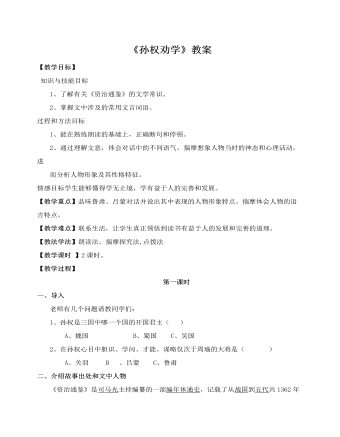
部编版语文七年级下册《孙权劝学》教案
二、介绍故事出处和文中人物《资治通鉴》是司马光主持编纂的一部编年体通史,记载了从战国到五代共1362年间的史事。司马光:字君实,陕州夏县人,北宋政治家、史学家。书名“资治”,说明本书编撰的目的是为封建统治阶级提供政治借鉴。孙权(182—252):字仲谋,吴郡富春人,三国时吴国的建立者。吕蒙:字子明,三国时吴国名将。三、朗读感知课文1、听朗读课文,注意人物对话的语气 (1)“卿今当涂掌事,不可不学!” 语重心长,谆谆告诫(2)“孤岂欲卿治经为博士邪!” (反问句,强调并不是要吕蒙研究儒家经典,当专掌经学传授的学官,而是有别的目的。)(3)“卿言多务,孰若孤?” 反问句,否定吕蒙辞以多务的理由。要重读强调(4)“卿今者才略,非复吴下阿蒙!” 感叹句,要显出惊讶不解的语气(5)“大兄何见事之晚乎!”反问句,指责中带有自豪的语气
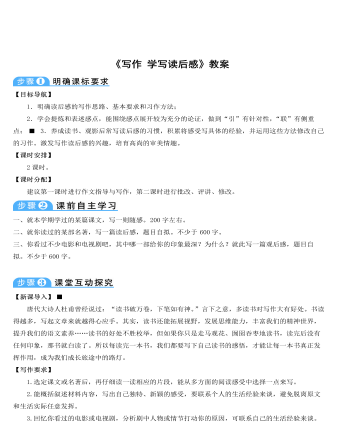
部编版语文八年级下册《写作:学写读后感》教案
【新课导入】唐代大诗人杜甫曾经说过:“读书破万卷,下笔如有神。”言下之意,多读书对写作大有好处。书读得越多,写起文章来就越得心应手。其实,读书还能拓展视野,发展思维能力,丰富我们的精神世界,提升我们的语文素养……读书的好处不胜枚举,但如果你只是走马观花、囫囵吞枣地读书,读完后没有任何印象,那书就白读了。所以每读完一本书,我们都要写下自己读书的感悟,才能让每一本书真正发挥作用,成为我们成长旅途中的路灯。【写作要求】1.选定课文或名著后,再仔细读一读相应的片段,能从多方面的阅读感受中选择一点来写。2.能概括叙述材料内容,写出自己独特、新颖的感受,要联系个人的生活经验来谈,避免脱离原文和生活实际任意发挥。3.回忆你看过的电影或电视剧,分析剧中人物或情节打动你的原因,可联系自己的生活经验来谈。【技法点拨】
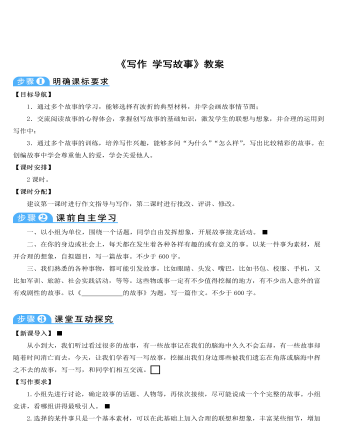
部编版语文八年级下册《写作:学写故事》教案
【目标导航】1.通过多个故事的学习,能够选择有波折的典型材料,并学会画故事情节图;2.交流阅读故事的心得体会,掌握创写故事的基础知识,激发学生的联想与想象,并合理的运用到写作中;3.通过多个故事的训练,培养写作兴趣,能够多问“为什么”“怎么样”,写出比较精彩的故事。在创编故事中学会尊重他人的爱,学会关爱他人。一、以小组为单位,围绕一个话题,同学自由发挥想象,开展故事接龙活动。二、在你的身边或社会上,每天都在发生着各种各样有趣的或有意义的事。以某一件事为素材,展开合理的想象,自拟题目,写一篇故事。不少于600字。三、我们熟悉的各种事物,都可能引发故事,比如眼睛、头发、嘴巴,比如书包、校服、手机,又比如军训、旅游、社会实践活动,等等。这些物或事一定有不少值得挖掘的地方,有不少出人意外的富有戏剧性的故事。以《 的故事》为题,写一篇作文。不少于600字。
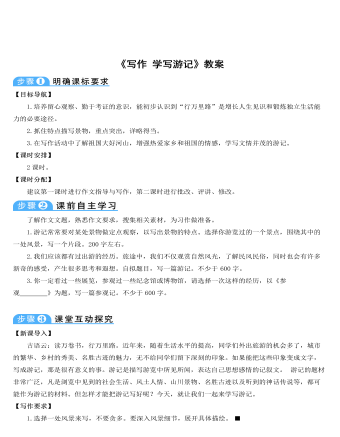
部编版语文八年级下册《写作:学写游记》教案
【目标导航】1.培养留心观察、勤于考证的意识,能初步认识到“行万里路”是增长人生见识和锻炼独立生活能力的必要途径。2.抓住特点描写景物,重点突出,详略得当。3.在写作活动中了解祖国大好河山,增强热爱家乡和祖国的情感,学写文情并茂的游记。【课时安排】2课时。【课时分配】建议第一课时进行作文指导与写作,第二课时进行批改、评讲、修改。了解作文文题,熟悉作文要求,搜集相关素材,为习作做准备。1.游记常常要对某处景物做定点观察,以写出景物的特点。选择你游览过的一个景点,围绕其中的一处风景,写一个片段。200字左右。2.我们应该都有过出游的经历。旅途中,我们不仅观赏自然风光,了解民风民俗,同时也会有许多新奇的感受,产生很多思考和遐想。自拟题目,写一篇游记。不少于600字。3.你一定看过一些展览,参观过一些纪念馆或博物馆,请选择一次这样的经历,以《参观 》为题,写一篇参观记。不少于600字。
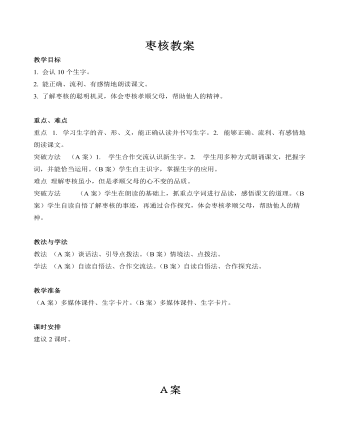
三年级下册《枣核》教案
精读课文,指导阅读1. 理解课文第1自然段。 (1)教师指名读,思考:这一个自然段讲了什么?(了解枣核出生的原因) (2)齐读第1自然段。2.理解第2~4自然段。 (1)理解:一年又一年,枣核一点儿也不见长,父母忧愁的原因。 (2)默读第2自然段,思考。(要给学生充分的时间读书、思考。为第3、4自然段的学习打下基础。) (3)自读第3~4自然段,回答问题。 ①枣核为什么让父母不用担心? ②枣核能做什么? ③大旱时发生了什么事? ④学生齐读。 ⑤提问:这一部分重点写了哪些方面?3.学习第5~13自然段。 (1)理解:大旱后,县衙门做了什么事?枣核又是怎么做的? (2)学生默读,思考。小组讨论、交流。 (3)全班交流,进一步深入理解。枣核的做法说明了什么?(联系上文,回答问题)而对枣核的决定,大家是怎样的态度?面对别人的不信任,枣核做出了怎样的选择?(板书:不争辩,靠行动说话)
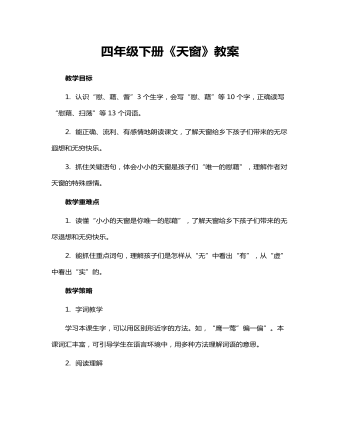
四年级下册《天窗》教案
教学目标1. 认识“慰、藉、瞥”3个生字,会写“慰、藉”等10个字,正确读写“慰藉、扫荡”等13个词语。2. 能正确、流利、有感情地朗读课文,了解天窗给乡下孩子们带来的无尽遐想和无穷快乐。3. 抓住关键语句,体会小小的天窗是孩子们“唯一的慰藉”,理解作者对天窗的特殊感情。教学重难点1. 读懂“小小的天窗是你唯一的慰藉”,了解天窗给乡下孩子们带来的无尽退想和无穷快乐。2. 能抓住重点词句,理解孩子们是怎样从“无”中看出“有”,从“虚”中看出“实”的。教学策略1. 字词教学学习本课生字,可以用区别形近字的方法。如,“鹰一莺”编一偏”。本课词汇丰富,可引导学生在语言环境中,用多种方法理解词语的意思。2. 阅读理解主要采用提出问题引导阅读的方式教学:先让学生带着疑问读课文,接着细读课文并思考天窗给乡下的孩子带来了什么,然后抓住文章的中心句“小小的天窗是你唯一的慰藉”一句理解课文,最后结合全文内容体会孩子被唤回家时的失落,又从天窗中想象出无穷的情形、故事,找回了失去的快乐。3. 表达运用运用读写结合的策略,学习课文后,启发学生结合自己的生活实际谈感受,写感受。教学准备1. 预习提纲:完成《状元大课堂·好学案》对应课文预习作业。2. 准备资料:多媒体课件。教学课时:2课时第1课时,课时目标:1. 认识“慰、藉、瞥”3个生字,会写“慰、藉”等10个字,正确读写“慰藉、扫荡”等13个词语。2. 能正确、流利地朗读课文,整体感知课文主要内容,理清课文脉络。教学过程板块一,设疑激趣,导入新课。1. 导入新课。(1) 课件出示天窗图片。(2) 师引导:同学们,你们知道这是什么吗?(3) 了解课文题目。师板书课题:天窗;指名读课题。(4) 设置疑问。师引导:看到课题,同学们有什么想问的吗?(示例:什么是天窗?)
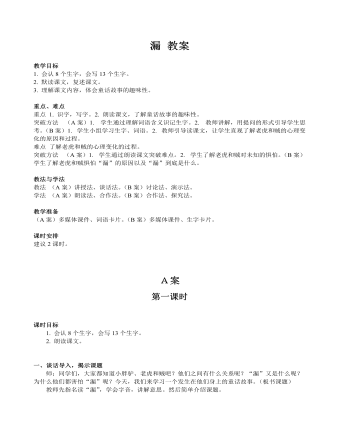
三年级下册《漏》教案
细读课文学生读课文,想想:“漏”指的是什么?学生自读、交流。1. 细读第1~5自然段。 (1)教师指名读,引导学生思考:这几个自然段主要告诉了我们什么? 师:“漏”指的是谁?老婆婆为什么说“什么都不怕,就怕漏”? (2)教师指导朗读。 教师指名试读,学生自由练读,最后集体齐读。2. 学习第6~18自然段。 (1)学生自由读课文,想想这些自然段讲了一个什么故事。 (2)教师指导朗读。学生自由练读,最后集体齐读。 (3)教师指名读选段,让学生说说老虎和贼之间发生了什么,为什么会出现这种情况。3. 学习第19~20自然段。 (1)教师指名读,要求学生思考:这两个自然段告诉了我们一件什么事? (2)天亮了,结果怎么样?(3)教师引导学生感受童话故事,体会其乐趣。
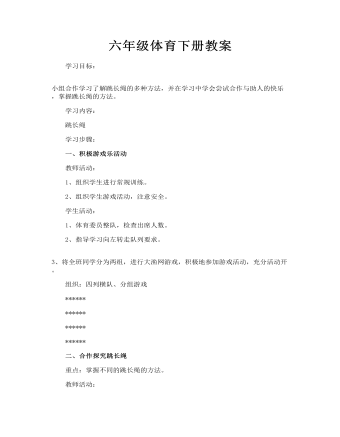
六年级体育下册教案
一、积极游戏乐活动 教师活动: 1、组织学生进行常规训练。 2、组织学生游戏活动,注意安全。 学生活动: 1、体育委员整队,检查出席人数。 2、指导学习向左转走队列要求。
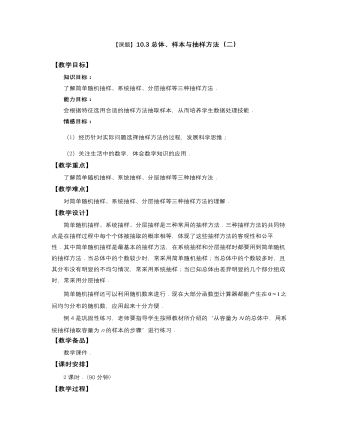
高教版中职数学基础模块下册:10.3《总体、样本与抽样方法》优秀教案设计
教 学 过 程教师 行为学生 行为教学 意图时间 *揭示课题 10.3总体、样本与抽样方法(二) *创设情境 兴趣导入 【问题】 用样本估计总体时,样本抽取得是否恰当,直接关系到总体特性估计的准确程度.那么,应该如何抽取样本呢? 介绍 质疑 了解 思考 启发 学生思考 0 5*动脑思考 探索新知 【新知识】 下面介绍几种常用的抽样方法. 1.简单随机抽样 从一批苹果中选取10个,每个苹果被选中的可能性一般是不相等的,放在上面的苹果更容易被选中.实际过程又不允许将整箱苹果倒出来,搅拌均匀.因此,10个苹果做样本的代表意义就会打折扣. 我们采用抽签的方法,将苹果按照某种顺序(比如箱、层、行、列顺序)编号,写在小纸片上.将小纸片揉成小团,放到一个不透明的袋子中,充分搅拌后,再从中逐个抽出10个小纸团.最后根据编号找到苹果. 这种抽样叫做简单随机抽样. 简单随机抽样必须保证总体的每个个体被抽到的机会是相同的.也就是说,简单随机抽样是等概率抽样. 抽签法(俗称抓阄法)是最常用的简单随机抽样方法.其主要步骤为 (1)编号做签:将总体中的N个个体编上号,并把号码写到签上; (2)抽签得样本:将做好的签放到容器中,搅拌均匀后,从中逐个抽出n个签,得到一个容量为n的样本. 当总体中所含的个体较少时,通常采用简单随机抽样.例如,从某班抽取10位同学去参加义务劳动,就可采用抽签的方法来抽取样本. 当总体中的个体较多时,“搅拌均匀”不容易做到,这样抽出的样本的代表性就会打折扣.此时可以采用“随机数法”抽样. 产生随机数的方法很多,利用计算器(或计算机)可以方便地产生随机数. CASIO fx 82ESPLUS函数型计算器(如图10-3),利用 · 键的第二功能产生随机数.操作方法是:首先设置精确度并将计算器显示设置为小数状态,依次按键SHIFT 、 MODE、 2 ,然后连续按键 SHIFT 、 RAN# ,以后每按键一次 = 键,就能随机得到0~1之间的一个纯小数. 采用“随机数法”抽样的步骤为: (1)编号:将总体中的N个个体编上号; (2)选号:指定随机号的范围,利用计算器产生n个有效的随机号(范围之外或重复的号无效),得到一个容量为n的样本. 讲解 说明 引领 分析 仔细 分析 关键 语句 观察 理解 记忆 带领 学生 分析 20
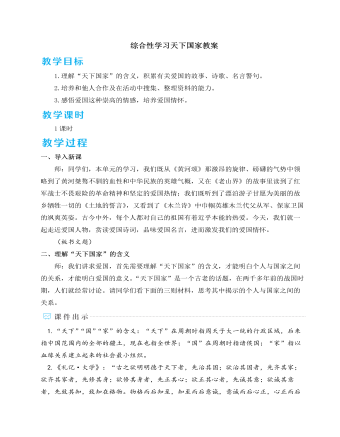
人教部编版七年级下册综合性学习天下国家教案
我荣幸地以中华民族一员的资格,而成为世界公民。我是中国人民的儿子。我深情地爱着我的祖国和人民。 ——邓小平一个人只要热爱自己的祖国,有一颗爱国之心,就什么事情都能解决。什么苦楚,什么冤屈都受得了。 ——冰心做人最大的事情是什么呢?就是要知道怎么样爱国。 ——孙中山能够献身于自己祖国的事业,为实现理想而斗争,这是最光荣不过的事情了。——吴玉章外国爱国名言示例:我们为祖国服务,也不能都采用同一方式,每个人应该按照资禀,各尽所能。——歌德纵使世界给我珍宝和荣誉,我也不愿离开我的祖国。因为纵使我的祖国在耻辱之中,我还是喜欢、热爱、祝福我的祖国。 ——裴多菲我重视祖国的利益,甚于自己的生命和我所珍爱的儿女。 ——莎士比亚我无论做什么,始终在想着,只要我的精力允许我的话,我就要首先为我的祖国服务。 ——巴甫洛夫
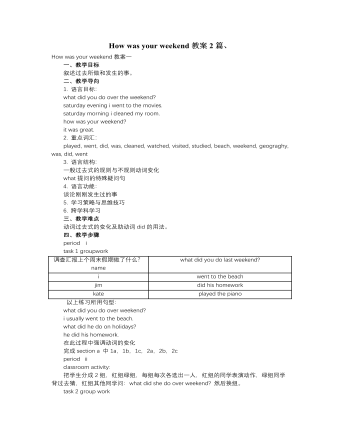
人教版新目标初中英语七年级下册How was your weekend教案2篇
Teaching Goal:1. General aims:Talk about recent past events2. Particular aims:A. Language Focus.Talk about recent past events and think of the past events.B. Language goalsHow was….?It was …What did …do over the weekend?C. Language structures:(1). How was your weekend? I was great. Pay attention to no form.(2). What did you do over the weekend? I played soccer. We went to the beach.D. Useful words and phrases:Words: was, did, went, beach, over, project, test, wasn’t, false, number, geography, spend, week, most, mixture, their, had, little, cook, read, saw, change, everyone, sit, sat, no, anythingPhrases: did one’s homework, played soccer, cleaned my room, went to the beach, played tennis, went to the movies, on Saturday morning, over the weekend, cook … for, what about, do some reading, have a party, talk show, go shoppingE. Grammar language:Present simple past tenseRegular and irregular verbsF. Learning strategies:Tour and holidaysG. Interdiscipinary:H. Emotion and manner:Teaching time: 5 periodsTeaching procedures:Period One教学步骤、时间 教师活动 学生活动 媒体应用Step 1Free talk 3’ Ask some questions like:Who’s on duty today?What’s the weather like? Answer and talk about something.让同学们回答下列问题1. Do you like weekend? (Let some students answer)It takes them three minutes to talk about the question.2. Why do you like weekend? (let the students answer) Most of the students like the weekend此时教师用汉语问:“在周末期间问你干了什么?这句话用英语这么回答?Let the students guess.At last the teacher give them right answer3. What did you do over the weekend?(板书、学习)
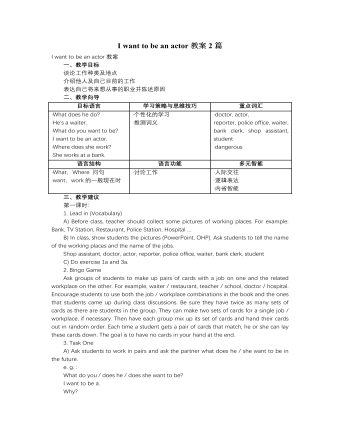
人教版新目标初中英语七年级下册I want to be an actor教案2篇
三、教学建议第一课时:1. Lead in (Vocabulary)A) Before class, teacher should collect some pictures of working places. For example: Bank, TV Station, Restaurant, Police Station, Hospital ...B) In class, show students the pictures (PowerPoint, OHP). Ask students to tell the name of the working places and the name of the jobs.Shop assistant, doctor, actor, reporter, police office, waiter, bank clerk, studentC) Do exercise 1a and 3a.2. Bingo GameAsk groups of students to make up pairs of cards with a job on one and the related workplace on the other. For example, waiter / restaurant, teacher / school, doctor / hospital. Encourage students to use both the job / workplace combinations in the book and the ones that students came up during class discussions. Be sure they have twice as many sets of cards as there are students in the group. They can make two sets of cards for a single job / workplace, if necessary. Then have each group mix up its set of cards and hand their cards out in random order. Each time a student gets a pair of cards that match, he or she can lay these cards down. The goal is to have no cards in your hand at the end.3. Task OneA) Ask students to work in pairs and ask the partner what does he / she want to be in the future.e. g. :What do you / does he / does she want to be?I want to be a.Why?Because it's (adj).B) Vocabulary: Section B, 1a4. Homework 1.2.
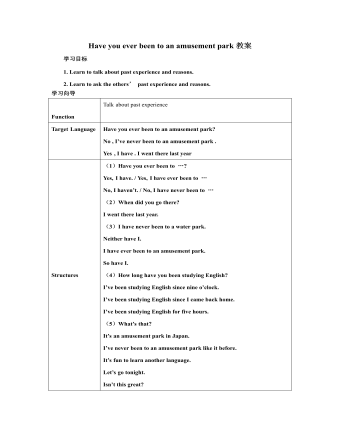
人教版新目标初中英语八年级下册Have you ever been to an amusement park教案
(1)Have you ever been to …? Yes, I have. / Yes, I have ever been to …No, I haven’t. / No, I have never been to …(2)When did you go there? I went there last year. (3)I have never been to a water park. Neither have I. I have ever been to an amusement park. So have I. (4)How long have you been studying English? I’ve been studying English since nine o’clock. I’ve been studying English since I came back home. I’ve been studying English for five hours. (5)What’s that? It’s an amusement park in Japan. I’ve never been to an amusement park like it before. It’s fun to learn another language. Let’s go tonight. Isn’t this great?space museum, amusement park, water park, South America, Peru, Holland, European culture, tour guide, flight attendant, musical instrument, more than, be from, get to, take lessons, neither, discover, graduate, change
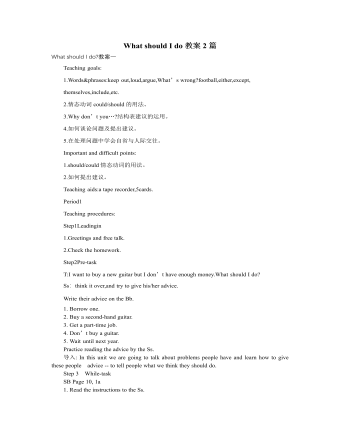
人教版新目标初中英语八年级下册What should I do教案2篇
说明:在帮Li Lei提建议的同时,教育学生如何学好英语。第三课时教学目标1. 语言目标:a) 词汇: Original, in style, haircut, the same as.b) 语言结构:My friend wears the same clothes and has the same haircut as I do.2. 能力目标:大多数学生能够谈论自己喜欢哪种服装,提高查找信息的能力。3. 情感目标:学会如何与朋友相处,要有自己对时尚的看法。教学重点掌握一些重要词汇。教学难点学会谈论问题,并能提出书面建议。◆教学突破首先针对Erin的问题,提出个人的建议,模仿2c部分的对话展开双人交际Pair-work;听老师诵读3a部分的信件,并找出LEFT OUT的问题所在;学生完成3b部分的内容,给Left Out提出书面的建议;学以口头形式提出自己目前存在的某个问题,讲给大家听,让同学们给自己提出一个建议,并作笔录;学生两、三个人分成一组,随意性地进行口语交际,谈论P14的第4部分的某个问题,相互交换意见。
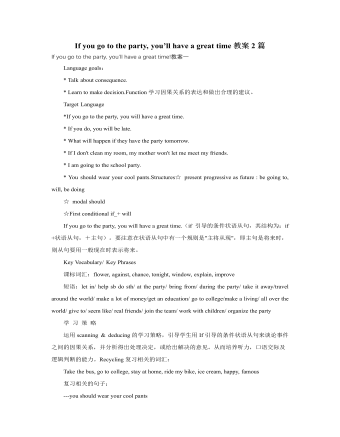
人教版新目标初中英语八年级下册If you go to the party, you’ll have a great time教案2篇
区分宾语从句、定于从句和状语从句宾语从句和状语从句,都叫做主从复合句。宾语从句主要是中考必考的,是初中阶段必掌握的从句,宾语从句主要是掌握三要素,所谓宾语从句,就是宾语在主从复合句当中充当宾语的一个句子,叫做宾语从句。主句的谓语动词是及物动词,后面如果是词或者是短语的话,是简单句,如果是句子的话,肯定是宾语从句。I know that he good at English.就是宾语从句,三要素,一要素是要注意连词,连词一共学了三类连词,一类连词是that口语当中可以省略,就像刚才说的那一句,I hear he is good at English.还有疑问代词、疑问副词,how where when,疑问代词、疑问副词。还有一类连词weather是否的意思,不是状语从句当中的如果,这一定要和如果区分开,这是是否。I don't know if he interested at English。宾语从句要注意if是连词。第二要素是语序,要用陈述举语序。比如说你家有几口人,我们都说How many people are there in you family?但是这是简单句,一旦说成宾语从句,你可以告诉我你家有几口人吗?Could you tell me how many people there are in you family ?
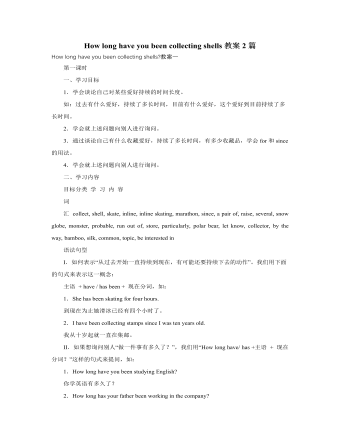
人教版新目标初中英语八年级下册How long have you been collecting shells教案2篇
Step Ⅱ Show the new words on the screen and teach the new words. Read the new words to students and ask them to repeat.Step Ⅲ 3aThis activity introduces new vocabulary and provides reading practice using the target language.In this activity first look at the four pictures.T: What can you see in the pictures?Ss: Four snow globes.T: Right. There are four snow globes in the pictures. And what are they?Ss: They are a monster, two polar bears, two penguins and a birthday cake.Write these words on the blackboard: snow globe; monster; polar bear; penguin and birthday cake. Read them to the class and ask students to repeat each one. Make sure students understand each word.Use a computer to show the E-mail message on the screen and read the message to students.Get students to read the e-mail on their own, and then draw lines connecting each snow globe and its description.Correct the answers.AnswersA line should connect each snow globe picture with the words that describe it in the letter.Step Ⅳ 3bThis activity provides writing practice using the target language.First review Activity 2a on Page 47.Then ask students to complete the message according to Activity 2a.Some partial sentences are given to students. Write about one person's collection.When students work, walk around the room checking the progress and offering help as needed.When they finish, ask some students to read their messages to the class.

人教版新目标初中英语八年级下册Why don’t you get her a scarf教案
教师带领学生复习有关描述宠物的词汇,采用教师提问学生回答的方进行。如:T:What animals do you think would be good pets?What animals do you think would be bad pets?What do you think are good animals for a six-year-old child?然后学生进行 pairwork 练习。Task two: 师生互动,学习探究 1、播放3a部分的录音,引导学生一边听录音,一边跟读。2、通过听录音学生回答以下问题:Why do you think pot-bellied pigs are popular?What are the advantages and disadvantages of keeping such a pet?教师对学生的回答进行及时点评。3.学习范文,学习重点短语,为下步的模仿写作提供语言素材。T :1. )Have you ever kept a pig as a pet?Do you like pigs? St.:No.…Why don’t you like to keep a pig? St: No.They’re too dirty and lazy(Do you know in some foreign countries like Hollyland, Australia,pigs are the most popular pet.there’s a kind of pig.(图)it has an interesting name? it ‘s called a pot-bellied pig.) Now,let’s learn an article about this kind of interesting pet.2.)play the tapeSt.:Listen and repeat3.)show some Qs on computer(本子St.: read silently,then answerthe Qs(本子)4.)Ask ss. Close book and retell this passage.(what is a pot-bellied pig? Is it a good or bad pet? ) St.: retell it to each other“A pot –bellied pig is a popular pet now…”5.read the article together.St.:.practice reading

人教版新目标初中英语八年级下册Would you mind turning down the music教案
Step 4. Group work (4)1. Ask a pair of students to read the dialogue. Say, This activity provides speaking, listening and writing practice using the target language.2. Ask students to complete the work in groups.3. Check the answers with the whole class. 4. Explain some of the language points. Step 5. Word review (Self check 1)1. Ask students to read the words and the phrases given. 2. Fill in the blanks with proper forms of these words to complete the sentences. 3. Check the answers with the whole class. Homework:Do activity 2 on page 57 after class. Period 6Teaching aims: 1. Teach vocabulary words and the useful expressions. 2. Enable the students to learn etiquette in different culture. 3. Help the students learn how to behave politely in public places and in daily life. Teaching procedures:Step 1. RevisionHelp students to review the function of making requests through a free talk. Then lead them to the topic of etiquette. Explain the meaning of etiquette. Or, ask students to look it up in the dictionary. Step 2. Pre-reading (Section 1)1. Ask students to read the picture and make a list with their partner about how many rules of etiquette can be seen being broken.
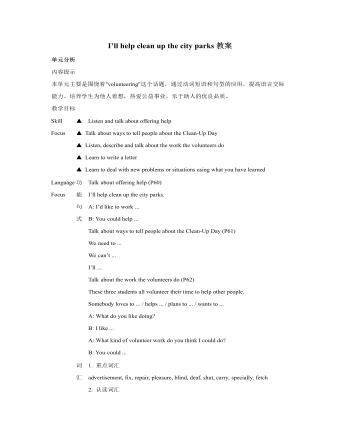
人教版新目标初中英语九年级下册I’ll help clean up the city parks教案
Talk about offering help (P60)I’ll help clean up the city parks.A: I’d like to work ...B: You could help ...Talk about ways to tell people about the Clean-Up Day (P61)We need to ...We can’t ...I’ll ...Talk about the work the volunteers do (P62)These three students all volunteer their time to help other people.Somebody loves to ... / helps ... / plans to ... / wants to ...A: What do you like doing?B: I like ... A: What kind of volunteer work do you think I could do?B: You could ...1. 重点词汇advertisement, fix, repair, pleasure, blind, deaf, shut, carry, specially, fetch2. 认读词汇hunger, homeless, cheer, clean-up, sign, establish, major, commitment, elementary, veterinarian, coach, similar, call-in, strategy, disabled, organization, unable, support, appreciate, donation, part of speech, pronoun, adverb, preposition, conjunction, donate, Jimmy, Sally3. 词组clean up, cheer up, give out, put off, set up, think up, take after, fix up, give away, put up, hand out, work out, at once
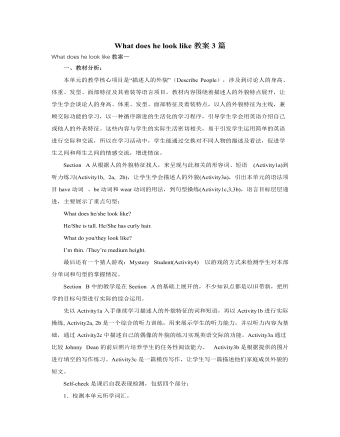
人教版新目标初中英语七年级下册What does he look like教案3篇
所需要用到的句子:Who is that?That is Jack. I like him.Why do you like him?I like him because he is interesting.Task 4: 设计理想中的人类Step one: 设计理想中的人类的外貌。把全班同学分成若干小组,学生可以边说边在纸上画出他们的模样。Step two: 设计理想中人类的性格。学生们可以把那些能描述性格的单词写在图画的旁边。Step three: 每组选出一名同学,其他同组同学提问,他作简单回答,并说明原因。所需用到的句子:What does he or she look like?He or she ...What is he or she like?He or she is ...Why?Because ...Task 5: 挑战性活动调查性格是天生的还是后天形成的,让每个同学回家去调查一下自己成长过程中性格是否有变化,具体是怎样的,为什么会这样? Teaching Aims:1. Enable students to have a general understanding of how to talk about people's physical appearance.2. Enable students to tackle some essential vocabularies and patterns about describing people. Provide them with necessary skills and methods.3. Create various chances for students to describe the persons they're familiar with, such as classmates, family members, teachers, idols, etc.
